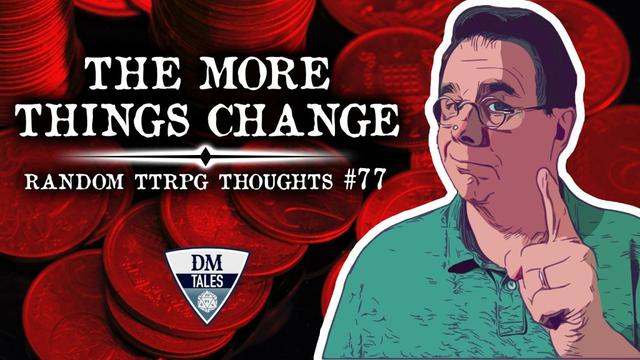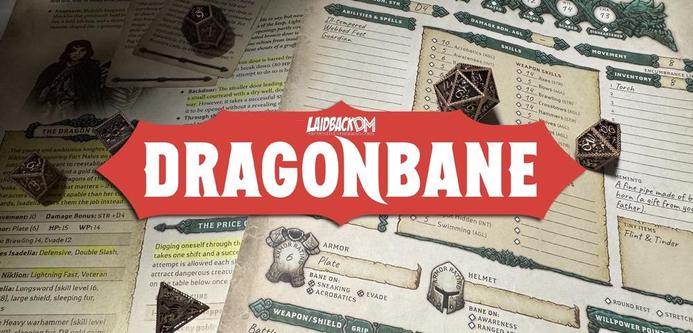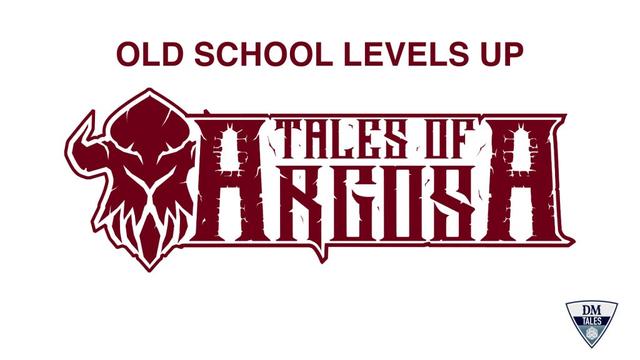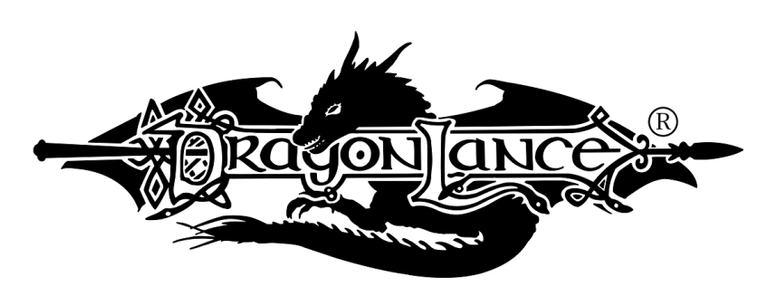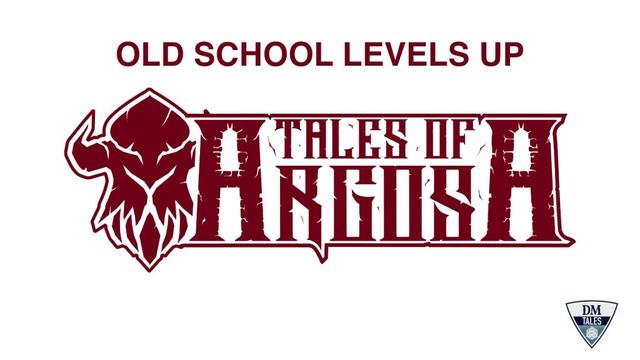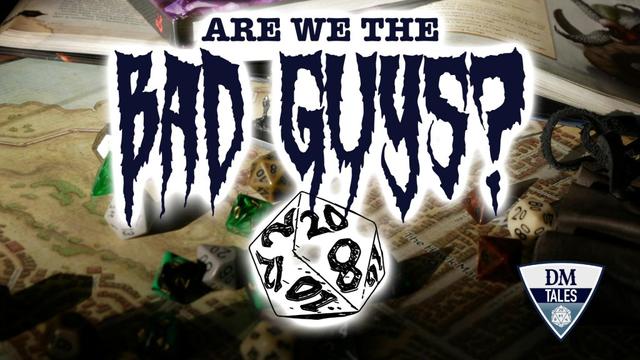Old School Levels UP
Tales of Argosa is the successor to 2019’s Low Fantasy Gaming and includes some updates to the core system which first appeared in Pickpocket Press’ second title, Lowlife 2090. The man behind Pickpocket Press, Stephen Grodzicki, was an early friend of DM Tales and sent me review copies of his earlier works, but I didn’t hesitate for a moment to back Tales of Argosa. He makes good stuff.
About Characters
Tales of Argosa is a low magic system weighted to be more human centric in the vein of old school Sword & Sorcery, with only a 25% chance of playing a non-human. Non-human characters do enjoy some benefits, but they also suffer from some racial penalties. This diverges from a lot of modern games which are migrating away from race-based mechanics, but it fits in the low-magic world of Argosa. It’s not that all non-humans have the same racial traits. It’s that non-humans who are hanging out in the human world have similar proclivities, which is what leads them away from their own cultures. Human characters, likewise, have racial modifiers which are indicative of the traits which drive them toward an adventuring lifestyle.
Classes
There are nine different classes, which cater to a wide range of play-styles. Artificers make dangerous gadgets, Barbarians are wilderness-loving rage-beasts, Bards inspire their companions, Cultists call down blessings from enigmatic entities, Fighters excel in combat situations, Magic Users wield forces they cannot control, Monks train to make their bodies weapons, Rangers work on the fringes of civilization, and Rogue embrace the shadows.
Each class has access to a set of skills which improve the chances for any check that falls into its bailiwick. Characters also expand their skillset as they level up—and may choose any skill which they feel matches their character’s story. Each class also has a list of starting equipment, which speeds up the “equipping” segment of character creation!
Characters further differentiate themselves through the addition of “unique features,” which they can add at levels 3, 6, and 9. These may either be developed in conjunction with the GM or picked from an example list found on pages 45-50 in the core rulebook. Unique features give some significant power boosts to the characters, but not ways that make them over powered. There are no “right” or “optimized” choices, only features which help make the character distinct while showing off a particular competency.
Each character also rolls for a background which grants a one time bonus to an attribute score, a skill, and an item for their inventory. It’s a simple way to provide some mechanical benefits while also functioning as fodder for a their backstory.
Attributes
There are seven rolled attributes in the game: Strength, Dexterity, Constitution, Intelligence, Perception, Willpower, and Charisma. An eight attribute, Initiative, is the average of Intelligence and Dexterity (rounded down).
A ninth attribute, Luck, is variable and begins an adventure at 10, plus ½ the character’s level (rounded up). First level characters, then, will begin an adventure with a Luck score of 11.
I enjoy the wide-range of character types in the game, and the ways characters can be differentiated from each other. Skill choices, backgrounds, and unique features help make characters from the same class stand out on their own. I appreciate this design.
Core Mechanics
There are a number of core mechanics in the game, though they tend to riff off of another.
Checks
Checks are the base mechanic of the game. Any time a player attempts to do something where there is a meaningful chance of failure a GM will call for a check against a specific attribute. If a character has a skill which would be applicable to the check then the attribute will get treated as 1 higher than normal for the roll. Having an appropriate skill also allows a character to use a reroll pool in case of failure. If a GM feels a situation is either easier or more difficult than an unmodified chance they may impose their own modifier, which alters the target rather than the roll.
Checks are made with d20 and are roll-under. If the number meets or is under the target the check succeeds and the action is successful. Rolls which are ½ the attribute are considered “Great Successes,” while those which are ½ the value over the rolled attribute are “Terrible Failures.” These will have both a narrative and mechanical effect on the game. While calculating the thresholds for triggering these is not difficult, there is a handy chart on page 64 in the core rulebook which shows the thresholds and is essential for any Tales of Argosa GM screen.
Luck
Luck is a special type of check, which replaces save mechanics from other games. It’s what gives Tales of Argosa its signature feel.
Luck checks are rolled other checks in the game. If the check succeeds the trap doesn’t hit, the falling rocks are dodged, or a tree root is grabbed which keeps a character from plunging to their untimely death. Luck checks will often be modified by an Attribute modifier, such as Luck(Dex) to dodge a hazard. In these cases the attribute’s modifier is added to the Luck score for the check.
But there is a twist. Each time a player rolls a successful Luck check the value decreases by one. As Luck regenerates only by one point per long rest, lengthy adventures or high stakes encounters feel more risky—because they are prone to sap Luck from the characters.
From the moment I first saw this Luck mechanic in Lowlife 2090 I was in love with it. And after playing a character for whom diminishing Luck was a real danger I’m hooked even more.
Magic
In Tales of Argosa the forces behind magical effects are both dangerous and beyond human comprehension. There are only two classes which can invoke magic-like effects—the arcane wielding Magic User, and the divinely-called Cultist.
Starting Magic Users know a number of spells equal to their intelligence modifier, which are selected via a d100 roll and consulting a chart. There are no spell levels in the game, everything is just “magic.”
Cultists, meanwhile, know a number of blessings equal to their Willpower score, though there far less of these in the game (12 in all). The limited scope of divine blessings conveys the alienness and distance of Argosa’s deities.
Arcane Magic
Magic users are only able to cast one spell per character level per adventure. But after casting their spell Argosa Magic Users are far from helpless. First, while they are not as combat-potent as more martial characters, ToA Magic Users are somewhat capable in combat. They begin with more hit points, may wear light armor, can wield a variety of weapons, and don’t have to wait for several levels to see their attack bonus increase. Second, Magic Users may replenish spent class abilities when they rest—one per short rest, and all expended uses during a long rest.
Casting an arcane spell requires an Intelligence(Arcane Lore) check. If the roll is successful, the spell goes off. If not the spell fails and that ability use is still expended. No matter the outcome, the player must then roll a “Dark and Dangerous Magic” check, with a die rolled according to the character’s level (a spell effect cast from a magic item always rolls a d20). If the roll is a 1 a Dark and Dangerous effect is triggered. Any other roll avoids a DDM effect, but the threshold increases by 1 every time an effect is not triggered. These cumulative increases remain until an effect is triggered, at which point the threshold resets to 1. Dark and Dangerous Magic effects are rolled on a table, and are wild. Characters may have their arms turn to tentacles, their ears might become pointed like a fey, or they may only be able to speak in a whisper. Some effects are permanent, while others can last anywhere from a few minutes to an entire year.
Blessings
Like Magic Users, Cultist begin play with the ability to invoke one blessing per character level.
To invoke a blessing Cultist must make Will(Divine Lore) check. For every invocation they must also make a Dark and Dangerous Magic check, just like a Magic User. If an effect is triggered, the Cultist suffers a Divine Rebuke and must roll on a table to see what it is. Many of these effects are permanent, and even those which are not may require a rite of atonement to end. In Argosa, if you draw a god’s attention, there is serious risk involved!
Magic in Tales of Argosa is a lot of fun.
Combat
Tales of Argosa combat will be familiar to many TTRPG players, “Roll high and add a modifer.” The target number to hit is determined by Armor Class, and attack rolls are modified by an attack bonus and attribute bonuses. A natural 1 on an attack roll triggers a fumble, while a natural 20 is a critical hit—doing max damage plus the character’s level. A nice tweak to the formula is a natural 19. These trigger special combat effects, such as trauma, and apply to both monster and weapon attacks.
Initiative is side based. At the start of a combat round, one player makes an initiative check. On a success, the players will go before normal adversaries. On a Great Success they will also go before adversaries who are marked as Bosses or Heavies. On a failure, adversaries go before the party. As combat progresses, an initiative check is made each round—moving around the table in clockwise order. Parties aren’t able to lean on characters who have good Initiative scores!
A character gets one move per turn, or two if they spend their action to do so. Movement in the game is approximated in bands.
- Melee (5 feet or so)
- Close (up to 30 feet)
- Far (into the next room or 60 feet)
- Very Far (over 60 feet)
Characters may move to anywhere in close or melee range in one move, and to anywhere in far range in two moves. Beyond that the number of moves it takes to reach anything in very far range is up to the GM. Movement cannot be broken up with an action unless a character is flying or mounted. It’s either “Action then move” or “Move then action.”
Exploits
When a combatant both hits and causes damage they may attempt an exploit which alters the current combat situation. These come in two varieties, Minor and Major. There are no hard rules for what differentiates one from the other. Instead, the player narrates what they want to attempt as an exploit and the GM decides which kind it is. There are, however, guidelines.
Minor Exploits may have one target, and are of limited duration. Shoving an adversary to put them off balance for example. Depending on what is attempted, the GM will call for some sort of check, which is often opposed. If a minor exploit fails that character may not attempt another minor exploit during that combat and, if there is a Terrible Failure the character will suffer a setback of the GM’s choosing.
Major Exploits are available only to the PCs, can affect more than one target, and cause long-lasting effects like blindness, shattering a weapon, or tossing an opponent off a cliff. Once a player narrates their intended exploit the GM calls for a Luck check, modified by the most appropriate attribute. As with Minor Exploits, when a Major Exploit fails, that character may not attempt one again that combat and a Terrible Failure causes some sort of setback. No Major Exploit can cause the death of an adversary unless that’s adversary’s hit dice are equal to or less than the PC’s level.
Exploits are fun, and when I was using them in combat it felt that they were what 5e’s bonus actions could have been. Players narrate the impact they intend to have on the combat by interacting with the emerging fiction, not by options based on their class. They’re really cool.
One last move, which is not limited to combat, is the rescue. When a character is faced with a calamitous situation, like falling off a cliff or suffering a deadly blow, a PC who is within close range may attempt to pull their ally to safety—even breaking initiative during combat.
To pull off a rescue, the player must describe what their character is doing to enact the rescue—like tackling their friend to avoid spell, holding up their shield as the killing blow comes down, or grabbing a rope and diving into lightning sand after the love of their life.
Once the rescue attempt is described the GM will determine if it makes sense and, if so, the player makes an Initiative check to see if they are quick enough to respond. If that succeeds the player then makes a Luck check to pull their friend to safety. If the Luck check fails, the character isn’t able to save their ally. On a Terrible Failure, the character suffers a setback which fits the fiction. Each character may only attempt one rescue per adventure.
Combat in Tales of Argosa is cinematic without being overpowering, fast, and fun.
Physical Book
Tales of Argosa is a full-sized book, 8 ½ by 11 inches, weighing at 266 pages. The offset book from the kickstarter campaign is printed on glossy paper, which bums me out. But it includes two book ribbons which is always a call for celebration. The book is stitched binding and lays open well, making it a pleasure to use at a table.
If you are ordering a physical copy of the game now the only way to do is via DriveThruRPG. This means that your copy will be printed on flat paper, have no ribbons, and will be glued binding (which is less durable). I have Pickpocket Press’ previous Print on Demand books, though, and they are beautiful. There may be a reprint of the offset printed book coming in 2026, so keep your eyes open.
The front cover of the book is stark and beautiful. The game’s title, in a distressed font, adorns the top of the front cover. This is a deep maroon, reminiscent of dried blood. The cover art is a reverse-contrast line-art of a party facing off against a giant serpent and some serpent-people. The rear cover is white, adorned only by the helmeted logo used for both Low Fantasy Gaming and Tales of Argosa in the same deep maroon. The presentation is phenomenal.
The end pages are filled with an abundance of tables which are perfect for a GM screen. There is a fantastic amount of information in them, which is presented well. These can be printed from the PDF and used with any screen a GM desires.
Interior Design
Tales of Argosa is both beautiful and stark.
There is almost no color in the book. The only exceptions are the first and second level headings, page numbers, and the tables.
The first heading is a stylized block-serif font, which evokes a feeling it’s evolved from ancient runes. Second level headings are a complimentary decorative serif font. Each is presented in the same maroon color found on the book cover.
Tables are set up with an alternating row color and clear header rows which utilize ToA’s signature maroon as the fill. The darker table rows are a deep peach with some really nice contrast.
The body font is an easy reading serif in black text
All the artwork in the book is black and white line art, which is perfect for conveying the game’s mood. This includes both the headers and footers, which look like bejeweled metal decorations.
In keeping with the minimalist design the page number is all that can be found in the footer, centered on the page. There is no information in the page header, however, and that might be my only critique of the design. It’s nice to see the section title on the pages.
Call outs are designed to look like ripped pieces of parchment, with subtle rips. They fit into the book very well.
All in all, this is a great design.
Conclusion
I love this game. It’s beautiful, fun, and simple to both play and run. At the same time it is filled with GM tools and mechanics I didn’t even have time to cover in this review! So I’m going to do a second Tales of Argosa review to cover things like the bestiary, special GM tools, and mechanics like montages, and mass combat! Even considering the shear amount of content, the game is not overwhelming. It relies on a well constructed engine, and is free enough that it gets out of the way when it’s not needed.
Try this game out, it’s fun.
If you want to pick up Tales of Argosa for yourself head over to DriveThruRPG. A hardcopy of the Standard hardcover plus PDF will set you back $44.95 and it is worth it. A PDF alone costs $24.95.
#DMing #DnD #DungeonsDragons #dungeonsAndDragons #GMing #OSR #RolePlayingGame #RPG #TTRPG
